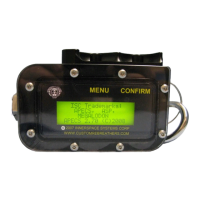______________________________________________________________________________________
Revision NEW APECS™ 2.7 5 of 19
Date: 10 July 2008
APECS ™ OPERATIONAL
INSTRUCTIONS (v. 2.7)
menu and press the
CONFIRM button and see the option lock into place into a submenu or some
operational information the diver may want to see.
WARNING! It is imperative that the diver NOT enter the water within two
minutes of power on to avoid the inadvertent selection of inappropriate
options.
The Diver at any time may leave the selected option by making a selected
operational change to the APECS™ or the system will time out in 5 seconds and
go back to the main diving informational screen.
WARNING! Always insure that you have a breathable P02 in the loop, and
set point that will also support your planned decompression.
CHANGE SP?: Set point selection is accessed from this option by pushing the
MENU button to “CHANGE SP?” Push the CONFIRM button to lock in the
option. The diver will see the first of the set points that can be locked in with the
CONFIRM button. The first set point is MAN. Man stands for manual. The
manual set point is an artificial set point of 0.20 and attempts to maintain a loop
PO2 of .20 (Air) at all times. The desired use is for swimming pool training,
surface swimming while breathing on the loop to avoid hypoxia, and for pre-
diving the Megalodon to avoid wasting oxygen through solenoid injection.
Set Points: The diver has the following set points that may be set on the fly
during the dive, or preset prior to entering the water; MAN, 0.5, 0.7, 1.0, 1.1, 1.2,
1.3, 1.4, and ASP. ASP stands for Auto Set Point. Auto Set Point is designed to
be used during rapid descents. ASP is normally selected immediately prior to
descent; as the diver descends and PO2 rises, ASP ensures that the PO2 does
not fall below current PO2 at any point. Once the descent is complete the diver
should select a fixed set point. The diver can select the maximum PO2 that ASP
will maintain on the SET MAX SET POINT menu.
WARNING! The diver must ensure that they have a breathable PO2 at all
times and maintain the planned PO2 to support the planned
decompression.
Other considerations are Oxygen CNS toxicity and Whole body Oxygen
toxicity, the planned PO2 must insure that all oxygen hazards are avoided by
prudent CCR diving practices. So use the oxygen set points wisely.
SYSTEM MONITOR: The second menu option after the CHANGE SP selection
is the SYSTEM MONITOR. The SYSTEM MONITOR page is the diagnoses

